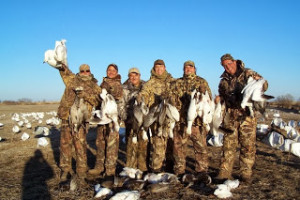 Spring snow goose hunting is fun, exciting, and – if timed right – a great time to hunt. While the geese are migrating, it’s the best time to hunt. Early in the season, the geese will not be on high alert for hunters, so you’ll have a much easier time decoying them in.
Spring snow goose hunting is fun, exciting, and – if timed right – a great time to hunt. While the geese are migrating, it’s the best time to hunt. Early in the season, the geese will not be on high alert for hunters, so you’ll have a much easier time decoying them in.
At Show Me Snow Geese, we’ve had years of experience and know the ins-and-outs of hunting snow geese in Missouri better than anyone else.
Our professional guides will guide you through the hunt, but for a first-timer, there is a lot you need to know to prepare for the big day.
Decoys and Spreads
It’s important to realize that snow geese are eating their food supply on the breeding grounds too fast. Ultimately, the food supply can’t replenish itself, so liberal hunting methods are allowed in the spring to control the population. The problem is that geese adapt to hunting season very quickly, so they’ll be much harder to kill after the first few weeks or so.
Decoys are placed in the hunting area so that snow geese are attracted to the area – safety in numbers. Called a spread, there can be as many as 1500 – 2500 decoys set out across the hunting area. We recommend that hunters setup their spreads early in the morning after scouting out the area the previous day.
Thousands of geese will be observing the spread, so it has to look as realistic as possible.
This is done through a variety of decoys:
- Motion based full bodies
- Wind socks
- Goose flags
- Flyer decoys and Vortex Machines
During our guided hunts, we supply all of the necessary decoys and only hunt in proven hunting grounds where geese are known to feed. For the first-time hunter, these decoys may be overwhelming , but they’re a necessity for consistent successful outings.
Shooting Recommendations
Novice hunters are anxious to pull their triggers. This leads to miscalculations and birds flying off before they are able to be hit. We recommend hunters waiting until geese are within a 25-yard range for the best results.
Guns and ammo are always a concern. If you bring the wrong gun, you’ll lower your chances of bagging your birds. Everyone has their own shotgun preference, but I prefer a 12 gauge. Why? A 12 gauge offers a few less pellets than a 10 gauge but it weight is much less, as is the cost per shell is much less.
You’ll want pellets with a fast velocity, so the shot leaves the barrel faster and retains it speed longer so when it reaches the bird mid-flight it still retains lethal momentum . Typically, 3” – 3 ½” shells work well although the kick is harder with 3 ½”. With all things being equal 3 ½” shells do not hit the birds any harder than the 3” but do carry more pellets.
Clothing Necessities
Especially during the start of the spring season, when you maybe dealing with snow and rain, which can make hunting uncomfortable if you’re not prepared. Dressing in layered warm clothes and bringing raingear, such as insulated waterproof jacket and bibs or pants, is a must. Also, make sure you bring more than one set of clothing along on your trip.
Since layout blinds are used, camouflage clothing is not a necessity, but it’s something most guides recommend any way since waterfowl can see colors . Facemasks, screens or face paint may also be worn to ensure you’re not detected by the geese. Insulated rubber boots and a pair of gloves will keep your feet and hands dry and warm.
Shell bags are one of my most recommended items. These bags will allow you to carry much-needed items, such as ammo, snacks, water and an extra pair of gloves or socks. We recommend bringing your camera along but because the flash and the chances of getting spotted by the geese posing for photos, photos are taken after the hunt. Spring snow goose hunting is all about concealment. You need to be prepared, so you’re never detected.
How Many Birds Will You Snag?
This is a good question, and it really depends on the time of year, the weather, the location and your shooting ability. It’s fair to say that most hunts will end with 20 – 40 birds killed. Have we had more? You bet. Many days we’ll have hunting parties that end up with fifty plus and on many hunts more than a hundred birds in single outing.
As guides, it’s impossible to know how many birds will be bagged in a day – all we can do is guide you – the rest will always vary.
Our guides know how to lead your hunting party to success. Using calls, decoys and the landscape, we’ll do everything in our power to provide the perfect spring snow goose hunting trip.












